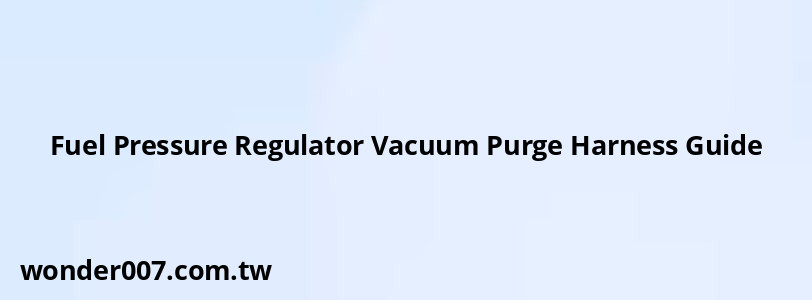Fuel Pressure Regulator Vacuum Purge Harness Guide

The Fuel Pressure Regulator Vacuum Purge Harness is a crucial component in a vehicle's fuel system, responsible for maintaining optimal fuel pressure across various engine operating conditions. This system ensures efficient fuel delivery and engine performance.
Functionality of Fuel Pressure Regulator Vacuum Purge Harness
The primary function of this harness is to connect the fuel pressure regulator to the engine's intake manifold vacuum. This connection allows the regulator to adjust fuel pressure based on engine load and throttle position. The system maintains a constant pressure differential across the fuel injectors, ensuring precise fuel delivery.
How It Works
When the engine is idling or under low load, there's high vacuum in the intake manifold. This vacuum is transmitted through the harness to the fuel pressure regulator, which then reduces fuel pressure. As engine load increases and throttle opens, manifold vacuum decreases, prompting the regulator to increase fuel pressure.
Key Components
The system consists of:
- Fuel pressure regulator
- Vacuum line
- Connections to the intake manifold
- Purge valve (in some systems)
Importance in Vehicle Performance
Proper functioning of the Fuel Pressure Regulator Vacuum Purge Harness is critical for:
- Optimal fuel economy
- Consistent engine performance
- Emissions control
- Smooth acceleration and throttle response
A malfunctioning system can lead to poor fuel economy, rough idling, and potential engine damage.
Maintenance Tips
To ensure the longevity and proper function of your Fuel Pressure Regulator Vacuum Purge Harness:
- Regularly inspect the vacuum lines for cracks or leaks
- Check connections for proper sealing
- Replace damaged components promptly
- Include system checks in routine vehicle maintenance
Common Issues
Be aware of these potential problems:
- Vacuum line leaks
- Clogged or damaged purge valve
- Faulty pressure regulator diaphragm
- Loose connections
Installation Guide
When installing or replacing a Fuel Pressure Regulator Vacuum Purge Harness:
1. Locate the fuel pressure regulator on the fuel rail
2. Identify the vacuum port on the intake manifold
3. Ensure the vacuum line is the correct size and material
4. Securely attach the line to both the regulator and manifold
5. Verify all connections are tight and leak-free
6. Start the engine and check for proper operation
Always consult your vehicle's manual or a professional mechanic for model-specific instructions.FAQs About Fuel Pressure Regulator Vacuum Purge Harness
- Can I drive without the vacuum line connected?
While possible, it's not recommended as it can lead to poor fuel economy and potential engine damage. - How often should I replace the vacuum line?
Replace it if you notice any cracks, leaks, or every 5-7 years as preventive maintenance. - What happens if the line is clogged?
A clogged line can cause incorrect fuel pressure regulation, leading to poor engine performance and potential stalling.
Understanding and maintaining your Fuel Pressure Regulator Vacuum Purge Harness is essential for keeping your vehicle running smoothly and efficiently. Regular checks and prompt addressing of any issues will help ensure optimal engine performance and longevity.
Related Posts
-
1999 Ford F150 Brake Line Diagram and Replacement Guide
30-01-2025 • 193 views -
Lincoln Town Car Climate Control Reset: A Comprehensive Guide
29-01-2025 • 146 views -
Lexus Dashboard Warning Lights: A Comprehensive Guide
26-01-2025 • 270 views -
Chevy Silverado Heater Control: Troubleshooting Guide
27-01-2025 • 191 views -
1994 Toyota Pickup: Front End Diagram and Parts Guide
28-01-2025 • 239 views
Latest Posts
-
Power Steering Fluid Leak On Passenger Side
01-02-2025 • 457 views -
2015 Chevy Traverse AC Recharge Port Location
01-02-2025 • 409 views -
How To Turn Off Paddle Shifters Mercedes
01-02-2025 • 377 views -
Rear Brake Caliper Piston Won't Compress
01-02-2025 • 356 views -
Are O2 Sensors Covered Under Warranty
01-02-2025 • 376 views
Popular Posts
-
EPC Light: Understanding Causes and Solutions
26-01-2025 • 1053 views -
Power Steering and ABS Light On: Causes and Solutions
27-01-2025 • 643 views -
Hino Warning Lights: Understanding Dashboard Alerts
26-01-2025 • 765 views -
EPC Warning Light: What It Means for Your Vehicle
27-01-2025 • 630 views -
V12 Engine Costs: What You Need to Know
26-01-2025 • 679 views
